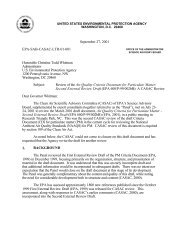EPA Region 10 Mercury Strategy Framework - Environmental ...
EPA Region 10 Mercury Strategy Framework - Environmental ...
EPA Region 10 Mercury Strategy Framework - Environmental ...
- No tags were found...
You also want an ePaper? Increase the reach of your titles
YUMPU automatically turns print PDFs into web optimized ePapers that Google loves.
<strong>EPA</strong> <strong>Region</strong> <strong>10</strong><strong>Mercury</strong> <strong>Strategy</strong> <strong>Framework</strong>Goal and ObjectivesGoal: Reduce human exposure to mercuryConsumption of contaminated fish is by far the most widespread source of human exposure to mercury. By reducingmercury levels in fish, we address the most significant human exposure, and also likely reduce the impacts to other aquaticand terrestrial receptors such as aquatic birds, mammals, and insect-eating songbirds. A less widespread but serious threatto human health is the continued occurrence of localized spills of elemental mercury in schools and homes. Additionaleffort is needed to raise awareness of elemental mercury risks, due to their public health significance and cost of cleanup.Objectives:• Characterize mercury levels in fish, water and sedimentin <strong>Region</strong> <strong>10</strong>.Determining current mercury levels in fish across theregion is a key first step to defining the extent of theproblem and current exposure, and enabling states andtribes to establish health advisories, where needed. Inaddition, assessing the extent of mercury in water andsediment will assist in further defining the sources ofmercury, and helping better understand how mercury istransported and chemically transformed in theenvironment.• Conduct public education/outreach.<strong>Region</strong> <strong>10</strong> will support state, tribal and national efforts toheighten awareness of mercury issues, such as via healthadvisories and pollution prevention efforts. Whereappropriate, <strong>Region</strong> <strong>10</strong> will take the lead in publiceducation/outreach efforts.• Characterize local mercury sources that impact<strong>Region</strong> <strong>10</strong>.<strong>Region</strong> <strong>10</strong> will continue to support efforts to characterizesources in and near R<strong>10</strong> which impact regionalwaterbodies. Efforts toward this work are underway, forexample, with the Columbia River Toxics Reductioneffort and the south Idaho atmospheric source attribution<strong>Region</strong>al Applied Research Endeavor (RARE) project.Additional work is needed to better characterize themagnitude and extent of atmospheric deposition,particularly from regional sources, and to map otherknown sources of mercury (Mining, RCRA andCERCLA sites, NPDES outfalls, air emissions, and nonpointsources) in relation to fish tissue levels.• Investigate key mercury fate and transport mechanisms.<strong>Region</strong> <strong>10</strong> will support efforts to better understand howmercury is transported and chemically transformed in theenvironment. In particular, characterizing key factorsdriving mercury’s conversion to methyl mercury, andinvestigating the transport of deposited mercury withinwatersheds, are two areas of immediate focus. The fateand transport of mercury may also be influenced byglobal climate change, but evaluating climate influencesis beyond this initial phase of the <strong>Strategy</strong>.• Take actions to control <strong>Region</strong>al sources of mercury.<strong>Region</strong> <strong>10</strong> will assist states and tribes in their efforts tocontrol regional sources of mercury under existingauthorities including the Clean Air Act, Clean Water Act,CERCLA, RCRA, and assist in developing nonregulatoryapproaches where appropriate.<strong>Mercury</strong> <strong>Strategy</strong> <strong>Framework</strong> - Page 3
















